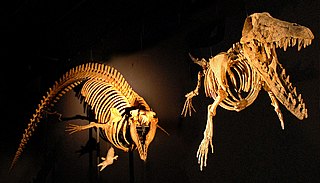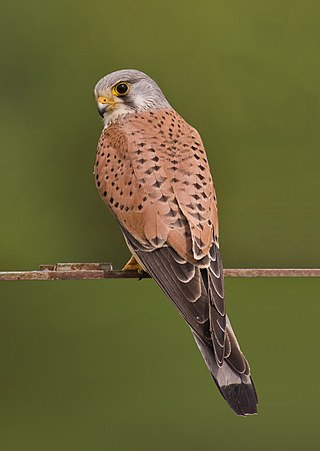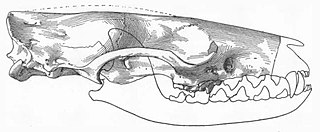
The Eocene is a geological epoch that lasted from about 56 to 33.9 million years ago (Ma). It is the second epoch of the Paleogene Period in the modern Cenozoic Era. The name Eocene comes from the Ancient Greek Ἠώς and καινός and refers to the "dawn" of modern ('new') fauna that appeared during the epoch.

The Paleogene Period is a geologic period and system that spans 43 million years from the end of the Cretaceous Period 66 Ma to the beginning of the Neogene Period 23.04 Ma. It is the first period of the Cenozoic Era, the tenth period of the Phanerozoic and is divided into the Paleocene, Eocene, and Oligocene epochs. The earlier term Tertiary Period was used to define the time now covered by the Paleogene Period and subsequent Neogene Period; despite no longer being recognized as a formal stratigraphic term, "Tertiary" still sometimes remains in informal use. Paleogene is often abbreviated "Pg", although the United States Geological Survey uses the abbreviation "Pe" for the Paleogene on the Survey's geologic maps.

Penguins are a group of aquatic flightless birds from the family Spheniscidae of the order Sphenisciformes. They live almost exclusively in the Southern Hemisphere: only one species, the Galápagos penguin, is found north of the Equator. Highly adapted for life in the ocean water, penguins have countershaded dark and white plumage and flippers for swimming. Most penguins feed on krill, fish, squid and other forms of sea life which they catch with their bills and swallow whole while swimming. A penguin has a spiny tongue and powerful jaws to grip slippery prey.

The Claroteidae are a family of catfish found in Africa. This family was separated from Bagridae. However, the monophyly of the family is sometimes contested.

Plotopteridae is an extinct family of flightless seabirds with uncertain placement, generally considered as member of order Suliformes. They exhibited remarkable convergent evolution with the penguins, particularly with the now extinct giant penguins. That they lived in the North Pacific, the other side of the world from the penguins, has led to them being described at times as the Northern Hemisphere's penguins, though they were not closely related. More recent studies have shown, however, that the shoulder-girdle, forelimb and sternum of plotopterids differ significantly from those of penguins, so comparisons in terms of function may not be entirely accurate. Plotopterids are regarded as closely related to Anhingidae (darters) and Phalacrocoracidae (cormorants). On the other hand, there is a theory that this group may have a common ancestor with penguins due to the similarity of forelimb and brain morphology. However, the endocast morphology of stem group Sphenisciformes differs from both Plotopteridae and modern penguins.

Archaeoceti, or Zeuglodontes in older literature, is a paraphyletic group of primitive cetaceans that lived from the Early Eocene to the late Oligocene. Representing the earliest cetacean radiation, they include the initial amphibious stages in cetacean evolution, thus are the ancestors of both modern cetacean suborders, Mysticeti and Odontoceti. This initial diversification occurred in the shallow waters that separated India and Asia 53 to 45 mya, resulting in some 30 species adapted to a fully oceanic life. Echolocation and filter-feeding evolved during a second radiation 36 to 35 mya.
Archaeospheniscus is an extinct genus of large penguins. It currently contains three species, known from somewhat fragmentary remains. A. wimani, the smallest species, was found in Middle or Late Eocene strata of the La Meseta Formation on Seymour Island, Antarctica, whereas the other two, about the size of a modern emperor penguin, are known from bones recovered from the Late Oligocene Kokoamu Greensand Formation at Duntroon, New Zealand.

Palaeeudyptes is an extinct genus of large penguins, currently containing four accepted species. They were probably larger than almost all living penguins, with the smaller species being about the size of an emperor penguin, and the largest species, Palaeeudyptes klekowskii, estimated to reach 2 meters (6.6 ft) long and weighed up to 116 kg (256 lb).

Palaeeudyptinae, the giant penguins, is a paraphyletic subfamily of prehistoric penguins. It includes several genera of medium-sized to very large species, such as Icadyptes salasi, Palaeeudyptes marplesi, Anthropornis nordenskjoeldi, and Pachydyptes ponderosus. Icadyptes reached 1.5 m in height, while members of Palaeeudyptes and Anthropornis grew even taller and were some of the largest penguins to have ever existed. The massive P. ponderosus may have weighed at least as much as an adult human.

Interatheriidae is an extinct family of notoungulate mammals from South America. Interatheriids are known from the Middle Eocene (Mustersan) to the Early Pleistocene (Uquian). These animals were principally small-sized, occupying a habitat like hares, marmots and viscachas. The majority were very small, like rodents.
Paleontology or palaeontology is the study of prehistoric life forms on Earth through the examination of plant and animal fossils. This includes the study of body fossils, tracks (ichnites), burrows, cast-off parts, fossilised feces (coprolites), palynomorphs and chemical residues. Because humans have encountered fossils for millennia, paleontology has a long history both before and after becoming formalized as a science. This article records significant discoveries and events related to paleontology that occurred or were published in the year 1979.

Glarichelys is an extinct genus of sea turtle which was originally considered to be from the middle Oligocene epoch but has more recently come to be considered from the Eocene epoch. It was first named by Zangerl in 1958.
The Mustersan age is a period of geologic time within the Eocene epoch of the Paleogene, used more specifically within the South American land mammal age (SALMA) classification. It follows the Casamayoran and precedes the Divisaderan age.
The Divisaderan age is a South American land mammal age, covering a period of geologic time within the Middle and Late Eocene epochs of the Paleogene. It follows the Mustersan age and is followed by the Tinguirirican age.
Karanisia is an extinct genus of strepsirrhine primate from middle Eocene deposits in Egypt.

Afrotarsius is a primate found in the Paleogene of Africa.
Perudyptes is a basal penguin from the Middle Eocene Paracas Formation of Peru. The genus name Perudyptes is named after the country, while the species name devriesi Thomas DeVries, a Vashon Island High School science teacher who has long worked in Peru.

Lesmesodon is an extinct genus of placental mammals from extinct family Proviverridae within extinct superfamily Hyaenodontoidea, that lived during the Early to Middle Eocene. It was found in France and in the Messel Pit in Germany. Lesmesodon was a weasel-sized carnivorous mammal.

Australaves is a clade of birds, defined in 2012, consisting of the Eufalconimorphae as well as the Cariamiformes. They appear to be the sister group of Afroaves. This clade was defined in the PhyloCode by George Sangster and colleagues in 2022 as "the least inclusive crown clade containing Cariama cristata and Passer domesticus".

Viverravus is an extinct genus of placental mammals from extinct subfamily Viverravinae within extinct family Viverravidae, that lived in North America, Europe and Asia from the middle Paleocene to middle Eocene.















